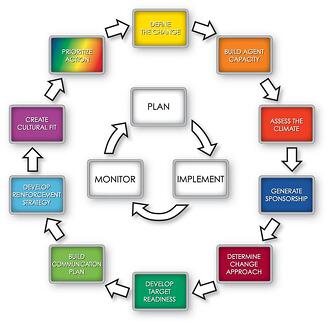One of the most common questions for clients who are looking for a change management methodology is "How does AIM (the Accelerating Implementation Methodology) compare to the Prosci methodology and the ADKAR model?" Let's first acknowledge that the Prosci methodology is a sound change management methodology. You might be surprised to hear us say that-- but it's true. So the question is, what change management framework is right for your organization? What are some of the important considerations for you to think about? 
1. Methodology Approaches
The Prosci methodology is a "linear approach" that provides users with a roadmap for implementing the change by completing a prescribed set of tools and templates. Because it is linear and somewhat prescriptive, it is a good methodology for beginners who are dealing with routine changes within a specific department or business unit.
AIM is built on the assumption that change is not linear; it is cyclical and "iterative." AIM is principle-based, meaning that users learn the principles, and then can call on those principles to know what to do given a set of circumstances. Since implementations are unpredictable, AIM is designed to guide you on what to do no matter what situation you face, with greater emphasis on gaining behavior change.
AIM is also designed to address systemic change. For simpler changes, it's scalable; users touch on only 5 core elements (out of the 10 in the complete system): 
- Defining the Change
- Generating Sponsorship
- Developing Target Readiness
- Building a Communications Plan
- Developing a Reinforcement Strategy
2. Organization Fit
Are you looking to apply the change management methodology on a simple project by project basis or do you also have the need to apply it on enterprise-wide changes where there are multiple projects, matrixed organization structures, multiple Sponsors, etc?
If all you are looking for is a simple set of checklists and templates that can be integrated into your projects, then the Prosci methodology and ADKAR model work well.
If you have a more complex organization where changes are going across multiple functional business units and where you are dealing with multiple Sponsors (enterprise-wide, transformational changes) then you will find the inherent scalability of AIM an attractive feature. AIM is an integrated system that can be used on any type or size/complexity project or change initiative, including culture changes.
2. Research-Based Foundation
Both AIM and the Prosci methodology are "research-based." The Prosci methodology captures best practices of change practitioners and updates the methodology based on survey results. AIM is based on behavioral science principles augmented by our "field research" of best practices--what we have observed has worked (and not worked) in implementing changes in organizations.
4. Tools and Templates
Yes, there are tools and templates available as part of both change management methodologies. The Prosci methodology is more tool and template driven and offers a wide number of checklists and templates, some of which are automated.
While AIM provides tools and templates as well, the AIM measurement diagnostics include a very robust set of measurement diagnostics that work in concert with the principles systemically to provide you with the "directional guidance" on where to best apply your finite resources.
5. Ease of Use
The prescriptive nature of the Prosci methodology makes it a simple approach to follow on a project. However, there are some limitations if you are dealing with a change that is not a formal project but where applying change management principles would be beneficial.
AIM is presented as a system with hard deliverables in a user-friendly package through color-coding. It's extrmely flexible and designed to be used in any situation in a "fit for purpose way." It is a repeatable process, but you don't have to apply the entire framework steps every time. Therefore, there is some judgment involved in determining which strategies and tactics are needed. For many users, the methodology becomes a "mind-set" that alters the way they assess formal project implementations as well as any kind of organizational change.
6. The Role of Leaders
Both methodologies put major emphasis on the need for leaders to serve as active Sponsors of changes.
The Prosci methodology talks about 3 actions being 1) participate actively and visibly; 2) build a coalition of managers and peers; and 3) communicate effectively with employees.
AIM takes a very direct and behavioral-based approach to the role of Sponsors and breaks down Sponsorship to include authorizing Sponsors (leaders at the top) and "reinforcing" Sponsors (all management level personnel) who must "express, model, and reinforce" their personal commitment to the changes. This behavioral-based approach emphasizes the importance of reinforcement of required new behaviors over simply communicating the importance of those behaviors.
How would you evaluate the differences?


